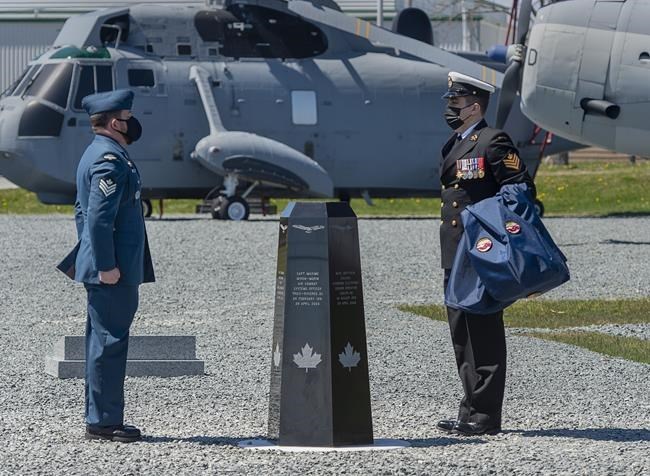EASTERN PASSAGE, N.S. — A stone monument was unveiled Thursday on the first anniversary of a naval helicopter crash that claimed the lives of six Canadian Forces personnel when the aircraft plunged into the ocean close to its host ship.
The black granite, six-faced memorial is four feet tall — the height is meant to evoke the fourth month of the year, as the crash occurred on the evening of April 29, 2020, in the Mediterranean Sea.
The top of the obelisk at the entrance of Canadian Forces Base Shearwater in Nova Scotia includes the crest of the Cyclone helicopter with its call sign, Stalker 22, embedded in the stone.
The call sign has been permanently retired, in memory of the largest single-day loss of life for the military in more than a decade.
Master Cpl. Matthew Cousins, Sub-Lt. Abbigail Cowbrough, Capt. Kevin Hagen, Capt. Brenden MacDonald, Capt. Maxime Miron-Morin and Sub-Lt. Matthew Pyke died in the crash.
Lt.-Col. Bill Thomey, commanding officer of 423 Squadron at Shearwater, said the ceremony would have normally been a major event, but the pandemic forced a quiet observance with just a few personnel present.
"We're doing what we can within the confines of the pandemic … and to show the families we're here for them and we're behind them," the officer said during an interview earlier in the day.
Some family members who live in the Halifax area — or who travelled to Nova Scotia and self-isolated — visited the monument on Wednesday in small groups, and a virtual ceremony was pre-recorded and released for the anniversary on Thursday.
The monument was unveiled for public viewing by two Canadian Forces personnel at 1:52 p.m. local time, the hour the helicopter went down near HMCS Fredericton.
A few people gathered, socially distanced, to observe in silence, as an aviator and a sailor saluted and then marched away.
During interviews earlier in the week, family members had said the memorial was important to honour the lost.
But the mother of a captain who died had said she is looking for more information from the final report into the cause of the crash, and had concerns about how swiftly the Royal Canadian Air Force allowed the Cyclones to return to service.
In June 2020, the military said preliminary findings indicated the helicopter did not respond the way the crew had expected as the aircraft was coming around to land on the Canadian frigate HMCS Fredericton.
At the time, Air Force officials said the pilot attempted to make a number of manoeuvres while the Cyclone's "flight director,'' or autopilot, was still engaged. Rather than turning off, the autopilot started to work against the pilot before the helicopter crashed into the water at high speed.
Thomey said Thursday the resumption of flights was accompanied by new training and updates to flight manuals so pilots are aware of the problem and how to respond.
“We’ve been able to really dial down and figure out exactly some of the procedures and put them into place and get educated on the incident that happened,” he said.
“If we’re unsure of anything, we’re going to put the brakes on and figure it out," Thomey said. "We’re not going to push forward blindly. We want to make sure if there’s an issue, we verify it and we will cancel training missions to ensure everyone feels comfortable and safe to go flying.”
Asked if the software of the flight control system has been changed, Thomey responded: “That (information) will all come out in due time with the release of the (safety) reports.”
A Cyclone recently had to land at a provincial park in Halifax after a warning light turned on, and it was towed back to the base in Eastern Passage.
Thomey said the helicopter had a fault light go on indicating a problem with its main rotorhead's hydraulic system. The rotorhead is the portion of the rotor assembly where the shafts of blades join the rotor.
He said there are multiple backup levels built into the helicopter, known as "redundancies," and the system was simply warning of a fault at one level.
“There is lots of redundancy built into the helicopter, triple redundancy in lot of cases, and the helicopter realized that, ‘Heh, we have a fault in one of systems,’" the officer said.
Thomey referred to the event as a “precautionary landing.”
He said two of the 16 Cyclones in the possession of the Canadian Forces are assigned to ships: one on HMCS Calgary and the other on HMCS Halifax. There are still 11 helicopters to be delivered to Canada by the American manufacturer.
This report by The Canadian Press was first published April 29, 2021.
Michael Tutton, The Canadian Press




